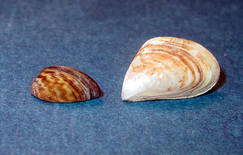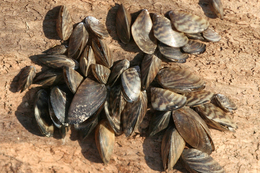| Click to make PDF of Guide! | Download latest spread prevention guide! |
 |
| Zebra (left) and quagga mussels Credit: USGS |
Dreissena polymorpha
History:
- Believed to be introduced to the Great Lakes during ballast water exchange from a cargo ship from the Black Sea
- Since being discovered in Great Lakes in 1988, the species has spread widely into freshwater habitats across North America
- Native to Black, Caspian, and Azov Seas
Characteristics:
- Named for the striped pattern on its shell - Black or brownish shell with cream or white stripes
- Shells colors vary widely; some pale or completely white
- Maximum size less than 2 in (5 cm) long; often less than 1 in
- Zebra shell is stable when placed on it's flattened hinge side while quagga mussels, lacking a flat side, fall over
- Valves (shell halves) are symmetrical, forming a straight line when closed whereas the quagga mussel valves are asymmetrical, forming a curved line when the valves are closed
Habitat:
- Lakes, estuaries, streams
- Attached to hard surfaces such as rocks, wood, and plants and to manmade structures of concrete, metal, and fiberglass
- Tolerate salinity to 6 ppt, temperatures to approximately 29 degrees C
Known Distribution:
- 21 states and 2 provinces including Quebec, New York, Vermont, Massachusetts, and Connecticut
Impacts:
- Voracious filter feeders, removing microscopic plants and animals from the water, reducing food available to other aquatic animals
- May cause declines in fish populations
- Clog intakes for power plants, industrial facilities, and public drinking water supplies
- Foul boat and ship hulls
- Economic impacts in the billions of dollars
Common Vector(s):
Overland transport (e.g. boats, equipment)Shipping: Ballast waterShipping: Fouling
 |
| Zebra mussels (Dreissena polymorpha) Credit: Whitney Cranshaw, Colorado State University |